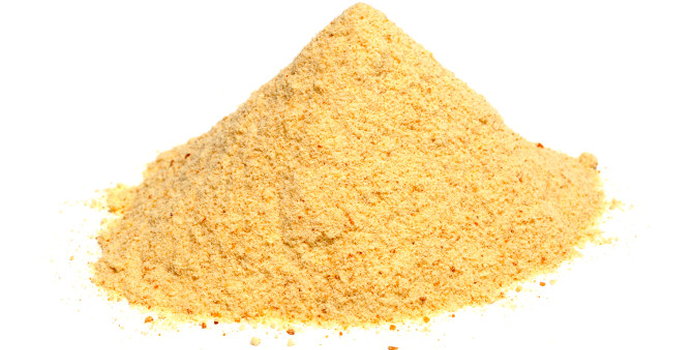


Many people are looking for gluten-free substitutions these days and those searching to replicate fried foods will be relieved to know that there is a way! Here are some gluten-free substitutions for the flour in the first stage of breading, although you might experience a slight difference in flavor. If you can grind it up into crumbs, you can use it in your breading. Try ground nuts, grated Parmesan cheese, cornflake crumbs, potato flakes, potato chips, tortilla chips. You could put anything in crumb form on the outside of your breaded foods. You don’t need to limit your breading mixtures to just breadcrumbs, however. Use a food processor or blender to process fresh bread to the right consistency to make fresh breadcrumbs, process toasted bread to make toasted or dried breadcrumbs, and process toasted bread along with some Italian dried herbs (like oregano and thyme) to make seasoned breadcrumbs. If you’re in a hurry, buying breadcrumbs is convenient, but it’s also very easy to make your own version of fresh, dried or seasoned breadcrumbs and they will probably taste better than a store-bought variety. Seasoned breadcrumbs can be purchased from stores and are breadcrumbs with a mixture of Italian dried herbs mixed in.Toasted or dried breadcrumbs are made from bread that has been previously toasted and consequently will give you a crispier coating than fresh breadcrumbs, but not as crispy as panko breadcrumbs.They produce a softer coating or crust on foods. Plain or fresh breadcrumbs are made from fresh bread and are finer than panko breadcrumbs.Because they resist absorbing oils, they will give you a crispier finish. Panko breadcrumbs are made from a crust-less white bread (although you can find a tan variety that is made with crusts as well) and are lighter, flakier and crispier than regular breadcrumbs.Sometimes it can get a little confusing, so below are all the different types of breadcrumbs that you’ll see called for in recipes. There are a lot of different types of breadcrumbs used in breading mixtures. We still need the oil with other cooking methods, but we can get away with using a whole lot less. In deep-frying, oil plays a big role in cooking the food, browning and keeping it moist. Oil will not only help brown the food, but also helps to keep the breadcrumbs or flour coating moist and prevents them from drying out. While with air-frying and oven baking you don’t submerge breaded foods in oil as you do with deep-frying, you will still need oil on the breading in order to optimize the browning. While it’s not completely necessary, chilling your breaded foods in the refrigerator for 10 to 15 minutes before pan frying or air-frying will give the breading more time to adhere to the food. The exception to this rule is when there is an ingredient in the mix that is inherently salty – like Parmesan cheese, pre-seasoned breadcrumbs or salted nuts. In order for the breading to be properly seasoned as well, however, you also need to season the breadcrumbs. Season the flour with salt and pepper, or season the food before dredging it in the flour. The only way to season the surface of the food is if you add salt and pepper to the first stage of breading. In most cases, you should season both the flour and the breadcrumb stages of your breading process. To every thing, there is a season… or at least there should be! The crumbs can’t hold onto the flour, so it’s the egg in between that keep the two together. The egg (or buttermilk) is the next step and it works as the glue between the flour and the crumbs. It’s the flour that will bind the two together and keep your breading where you want it to be – on the food.

If you didn’t coat a chicken breast in flour, for instance, the egg would just slide right off the slippery chicken. The flour creates a dry surface on the wet or moist food and it’s this dry surface that the egg will hold on to in the next step. There are usually three steps to breading foods and they are all important so don’t skip a step! Although it might feel counter-intuitive, the first step in breading is to coat with flour. Remember – flour first, then egg, then crumbs… Here’s how you can achieve both of those goals. The keys to successful breading is to make sure the food is tasty AND to make sure the breading stays on the food and doesn’t fall off during cooking. It’s this exterior breading that is so important to the finished dish, so consequently the process of breading is a very important step. Some foods are not just dredged in flour, but breaded too in order to enhance flavor and texture. For instance, sometimes we dredge meats with flour before sautéing to enhance browning and to create a crispier texture on the outside. Dredging is a culinary technique used to coat a wet ingredient with a dry ingredient before cooking.


 0 kommentar(er)
0 kommentar(er)
